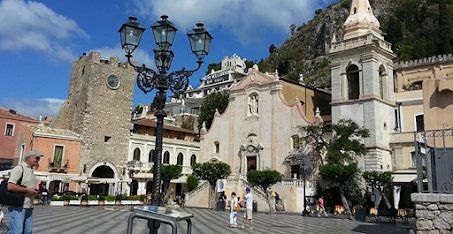The square is known for the breathtaking view of the azure Ionian Sea and of the Mount Etna.
Lined with pricey cafés and brimming with visitors and caricature artists, it's the best place to sit back with a cappuccino and enjoy the relaxed ambience of Taormina.
The square was named after the 9th of April, 1860, when mass in the Taormina cathedral down the street was interrupted to announce that Garibaldi had landed at Marsala (on the far side of the island) to begin his conquest of Sicily that made it part of Italy
Actually, the news proves false. In fact Garibaldi landed at Marsala exactly one month later, on 9 May 1860. However, the inhabitants of Taormina wanted to recall that date dedicating the most beautiful square.
PALERMO
The church's origins date to the 6th century. After the establishment of the Norman domination of southern Italy, it was returned to the Christians by Roger II of Sicily who, around 1136, entrusted it to the Benedictine monks of Saint William of Vercelli.
The church was extensively modified during the following centuries. A restoration held around 1880 attempted to restore its original medieval appearance.
The church is notable for its brilliant red domes, which show clearly the persistence of Arab influences in Sicily at the time of its reconstruction in the 12th century, the Arab-Norman culture. In her 1882 Diary of an Idle Woman in Sicily, Frances Elliot described it as "... totally oriental... it would fit well in Baghdad or Damascus". However, the red colour of the domes are not original, as they were restored in the present way at the end of the nineteenth century by an architect who found pieces of red plaster on the domes and therefore decided to paint all the domes in red.
The church lies with a flank on a square construction. The church is on the Latin Cross plan with a nave and two aisles and three apses. Each of the square spans is surmounted by a dome. The presbytery, ending with a niche, has also a dome.
The cloister, enriched by a luxurious garden, is the best preserved part of the ancient monastery. It has notable small double columns with capitals decorated by vegetable motifs, which support ogival arches. It also includes an Arab cistern.
CASEIFICIO BODERI









No comments:
Post a Comment